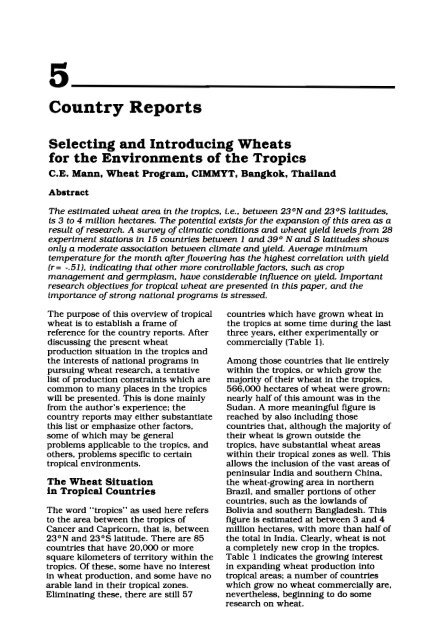the Symposium on Wheats for More Tropical Environments - cimmyt
the Symposium on Wheats for More Tropical Environments - cimmyt
the Symposium on Wheats for More Tropical Environments - cimmyt
- No tags were found...
You also want an ePaper? Increase the reach of your titles
YUMPU automatically turns print PDFs into web optimized ePapers that Google loves.
5 _Country ReportsSelecting and Introducing <strong>Wheats</strong><strong>for</strong> <str<strong>on</strong>g>the</str<strong>on</strong>g> Envir<strong>on</strong>ments of <str<strong>on</strong>g>the</str<strong>on</strong>g> TropicsC.E. Mann, Wheat Program, CIMMYT, Bangkok, ThailandAbstractThe estimated wheat area in <str<strong>on</strong>g>the</str<strong>on</strong>g> tropics, i.e., between 23ON and 23°5 latitudes,is 3 to 4 milli<strong>on</strong> hectares. The potential exists<strong>for</strong> <str<strong>on</strong>g>the</str<strong>on</strong>g> expansi<strong>on</strong> ofthis area as aresult ofresearch. A survey ofclimatic c<strong>on</strong>diti<strong>on</strong>s and wheat yield levels from 28experiment stati<strong>on</strong>s in 15 countries between 1 and 39° Nand S latitudes shows<strong>on</strong>ly a moderate associati<strong>on</strong> between climate and yield. Average minimumtemperature<strong>for</strong> <str<strong>on</strong>g>the</str<strong>on</strong>g> m<strong>on</strong>th afterflowering has <str<strong>on</strong>g>the</str<strong>on</strong>g> highest correlati<strong>on</strong> with yield(r= -.51), indicating that o<str<strong>on</strong>g>the</str<strong>on</strong>g>r more c<strong>on</strong>trollablefactors, such as cropmanagement and germplasm, have c<strong>on</strong>siderable influence <strong>on</strong> yield. Importantresearch objectives<strong>for</strong> tropical wheat are presented in this paper, and <str<strong>on</strong>g>the</str<strong>on</strong>g>importance ofstr<strong>on</strong>g nati<strong>on</strong>al programs is stressed.The purpose of this overview of tropicalwheat is to establish a frame ofreference <strong>for</strong> <str<strong>on</strong>g>the</str<strong>on</strong>g> country reports. Afterdiscussing <str<strong>on</strong>g>the</str<strong>on</strong>g> present wheatproducti<strong>on</strong> situati<strong>on</strong> in <str<strong>on</strong>g>the</str<strong>on</strong>g> tropics and<str<strong>on</strong>g>the</str<strong>on</strong>g> interests of nati<strong>on</strong>al programs inpursuing wheat research, a tentativelist of producti<strong>on</strong> c<strong>on</strong>straints which arecomm<strong>on</strong> to many places in <str<strong>on</strong>g>the</str<strong>on</strong>g> tropicswill be presented. This is d<strong>on</strong>e mainlyfrom <str<strong>on</strong>g>the</str<strong>on</strong>g> author's experience; <str<strong>on</strong>g>the</str<strong>on</strong>g>country reports may ei<str<strong>on</strong>g>the</str<strong>on</strong>g>r substantiatethis list or emphasize o<str<strong>on</strong>g>the</str<strong>on</strong>g>r factors,some of which may be generalproblems applicable to <str<strong>on</strong>g>the</str<strong>on</strong>g> tropics, ando<str<strong>on</strong>g>the</str<strong>on</strong>g>rs, problems specific to certaintropical envir<strong>on</strong>ments.The Wheat Situati<strong>on</strong>in <strong>Tropical</strong> CountriesThe word "tropics" as used here refersto <str<strong>on</strong>g>the</str<strong>on</strong>g> area between <str<strong>on</strong>g>the</str<strong>on</strong>g> tropiCS ofCancer and Capricorn, that is, between23°N and 23°5 latitude. There are 85countries that have 20,000 or moresquare kilometers of territory within <str<strong>on</strong>g>the</str<strong>on</strong>g>tropics. Of <str<strong>on</strong>g>the</str<strong>on</strong>g>se, some have no interestin wheat producti<strong>on</strong>, and some have noarable land in <str<strong>on</strong>g>the</str<strong>on</strong>g>ir tropical z<strong>on</strong>es.Eliminating <str<strong>on</strong>g>the</str<strong>on</strong>g>se. <str<strong>on</strong>g>the</str<strong>on</strong>g>re are still 57countries which have grown wheat in<str<strong>on</strong>g>the</str<strong>on</strong>g> tropics at some time during <str<strong>on</strong>g>the</str<strong>on</strong>g> lastthree years, ei<str<strong>on</strong>g>the</str<strong>on</strong>g>r experimentally orcommercially (Table 1).Am<strong>on</strong>g those countries that lie entirelywithin <str<strong>on</strong>g>the</str<strong>on</strong>g> tropics, or which grow <str<strong>on</strong>g>the</str<strong>on</strong>g>majority of <str<strong>on</strong>g>the</str<strong>on</strong>g>ir wheat in <str<strong>on</strong>g>the</str<strong>on</strong>g> tropics,566,000 hectares of wheat were grown;nearly half of this amount was in <str<strong>on</strong>g>the</str<strong>on</strong>g>Sudan. A more meaningful figure isreached by also including thosecountries that, although <str<strong>on</strong>g>the</str<strong>on</strong>g> majority of<str<strong>on</strong>g>the</str<strong>on</strong>g>ir wheat is grown outside <str<strong>on</strong>g>the</str<strong>on</strong>g>tropics, have substantial wheat areaswithin <str<strong>on</strong>g>the</str<strong>on</strong>g>ir tropical z<strong>on</strong>es as well. Thisallows <str<strong>on</strong>g>the</str<strong>on</strong>g> inclusi<strong>on</strong> of <str<strong>on</strong>g>the</str<strong>on</strong>g> vast areas ofpeninsular India and sou<str<strong>on</strong>g>the</str<strong>on</strong>g>rn China,<str<strong>on</strong>g>the</str<strong>on</strong>g> wheat-growing area in nor<str<strong>on</strong>g>the</str<strong>on</strong>g>rnBrazil, and smaller porti<strong>on</strong>s of o<str<strong>on</strong>g>the</str<strong>on</strong>g>rcountries, such as <str<strong>on</strong>g>the</str<strong>on</strong>g> lowlands ofBolivia and sou<str<strong>on</strong>g>the</str<strong>on</strong>g>rn Bangladesh. Thisfigure is estimated at between 3 and 4milli<strong>on</strong> hectares, with more than half of<str<strong>on</strong>g>the</str<strong>on</strong>g> total in India. Clearly, wheat is nota completely new crop in <str<strong>on</strong>g>the</str<strong>on</strong>g> tropics.Table 1 indicates <str<strong>on</strong>g>the</str<strong>on</strong>g> growing interestin expandJng wheat producti<strong>on</strong> intotropical areas; a number of countrieswhich grow no wheat commercially are,never<str<strong>on</strong>g>the</str<strong>on</strong>g>less, beginning to do someresearch <strong>on</strong> wheat.

















